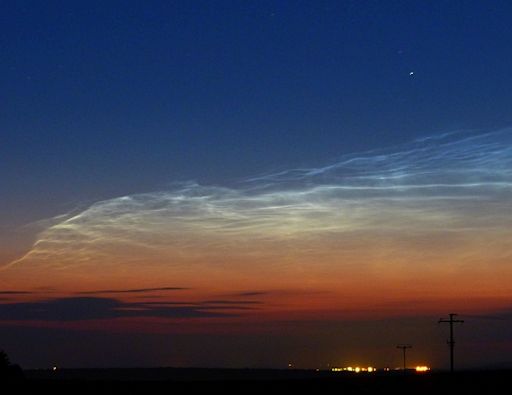 07-2-2014, 06:31 AM
07-2-2014, 06:31 AM
|
#977
|
|
⊙▃⊙
  
Join Date: Nov 2007
Location: I live in the last place where you Look.
Age: 31
Posts: 7,376
|
 Re: Terry's Astronomy Thread.
Re: Terry's Astronomy Thread.
Daily Suspicious0bserver's Weather Post:
July 2, 2014
What's in the sky tonight?
July 2, 2014
-For people in the northern hemisphere, July is the best time of the year to see noctilucent clouds (NLCs). The month got off to a good start on July 1st when the sunrise over Radebeul, Germany turned electric-blue. "This morning was extremely electric blue over Saxony," says photograher Heiko Ulbricht. "What a great display of noctilucent clouds! I spent much of the night watching the World Cup with friends. At about 2 o'clock in the morning, we drove to a field in Radebeul near the Astronomical Observatory. When the sun came up we were rewarded--a great morning! "
NLCs are Earth's highest clouds. Seeded by "meteor smoke," they form at the edge of space 83 km above Earth's surface. When sunlight hits the tiny ice crystals that make up these clouds, they glow electric blue.
NLCs appear during summer because that is when water molecules are wafted up from the lower atmosphere to mix with the meteor smoke. That is also, ironically, when the upper atmosphere is coldest, allowing the ice crystals of NLCs to form.
The natural habitat of noctilucent clouds is the Arctic Circle. In recent years, however, they have spread to lower latitudes with sightings as far south as Utah and Colorado. This will likely happen in 2014 as well. Observing tips: Look west 30 to 60 minutes after sunset when the Sun has dipped 6o to 16o below the horizon. If you see luminous blue-white tendrils spreading across the sky, you may have spotted a noctilucent cloud.
 Astro Picture of the Day:
July 2, 2014
Source:
Astro Picture of the Day:
July 2, 2014
Source:
Spiral galaxy NGC 4651 is a mere 62 million light-years distant, toward the well-groomed northern constellation Coma Berenices. About the size of our Milky Way, this island universe is seen to have a faint umbrella-shaped structure that seems to extend (left) some 100 thousand light-years beyond the bright galactic disk. The giant cosmic umbrella is now known to be composed of tidal star streams - extensive trails of stars gravitationally stripped from a smaller satellite galaxy. The small galaxy was eventually torn apart in repeated encounters as it swept back and forth on eccentric orbits through NGC 4651. In fact, the picture insert zooms in on the smaller galaxy's remnant core, identified in an extensive exploration of the system, using data from the large Subaru and Keck telescopes on Mauna Kea. Work begun by a remarkable collaboration of amateur and professional astronomers to image faint structures around bright galaxies suggests that even in nearby galaxies, tidal star streams are common markers of such galactic mergers. The result is explained by models of galaxy formation that also apply to our own Milky Way.
|

|

|